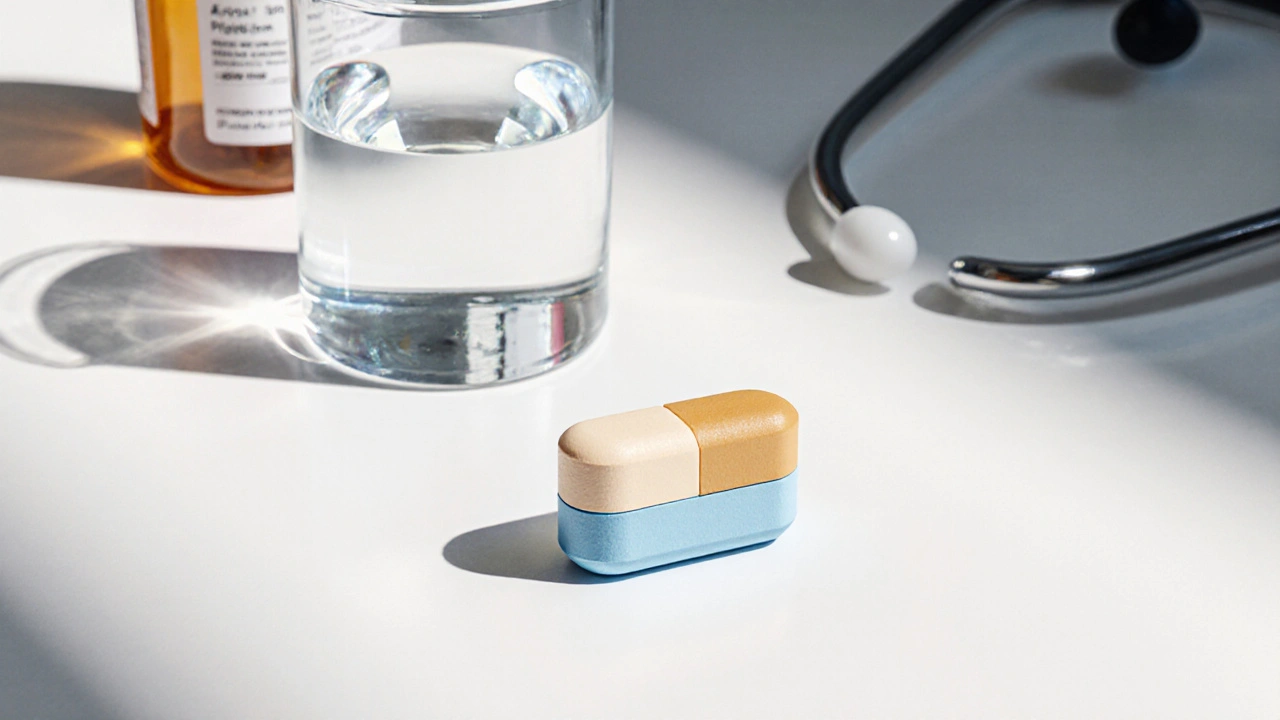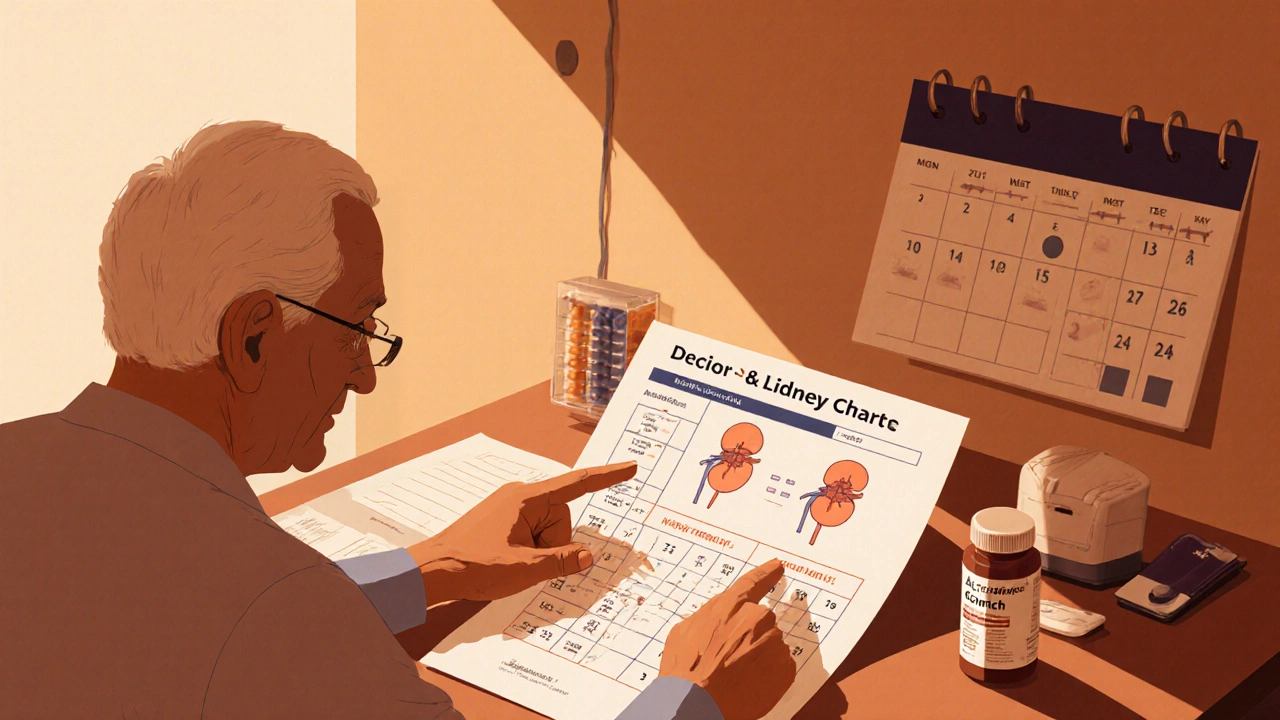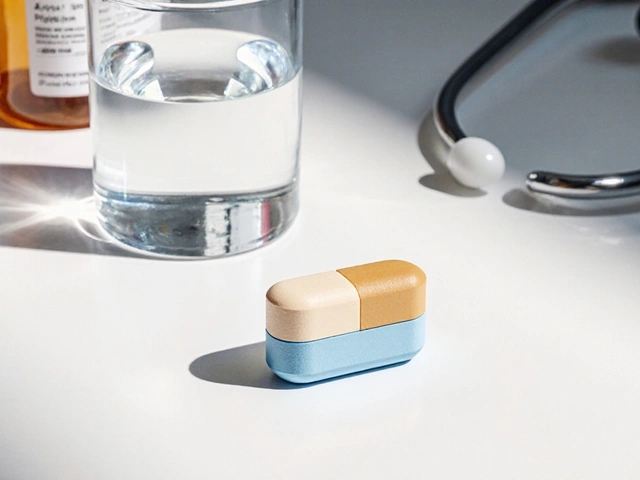Actoplus Met vs Alternatives: Metformin & Pioglitazone Comparison

Diabetes Treatment Comparison Tool
Treatment Comparison Guide
This tool helps you understand which diabetes treatment option might be most appropriate based on your individual health factors. Based on the article content about Actoplus Met versus alternatives.
When dealing with type 2 diabetes, you’ll often hear about combination pills that try to hit two targets at once. Actoplus Met is one of those combos - it bundles Metformin and Pioglitazone in a single tablet.
Key Takeaways
- Actoplus Met merges two proven drugs: Metformin (first‑line) and Pioglitazone (insulin sensitizer).
- It lowers HbA1c about 1.5-2.0% on average, similar to many newer agents.
- Side‑effects include gastrointestinal upset (mostly from Metformin) and fluid retention (from Pioglitazone).
- Cost is usually lower than branded GLP‑1 agonists but higher than Metformin alone.
- Choosing Actoplus Met depends on your kidney function, heart health, and how you tolerate each component.
What Is Actoplus Met?
Actoplus Met is a fixed‑dose combination (FDC) pill approved by the FDA in 2015. Each tablet typically contains 500mg of Metformin and 15mg of Pioglitazone, though higher strengths exist for patients needing more aggressive control.
The drug works by hitting two pathways: Metformin reduces hepatic glucose production and improves peripheral insulin sensitivity, while Pioglitazone activates PPAR‑γ receptors to boost how muscle and fat cells respond to insulin. The result is a double‑pronged attack on high blood sugar.
Metformin Alone: The Baseline
Metformin has been the cornerstone of type2 diabetes therapy for decades. Typical doses start at 500mg once daily, titrating up to 2000mg split across a day. It lowers HbA1c by roughly 1.0-1.5% and is weight‑neutral or modestly weight‑lossing.
Side‑effects center on the gut: nausea, diarrhea, and a metallic taste. A rare risk is lactic acidosis, which makes it unsuitable for patients with severe kidney impairment (eGFR <30mL/min/1.73m²).

Pioglitazone Alone: The Insulin Sensitizer
Pioglitazone belongs to the thiazolidinedione (TZD) class. Doses range from 15mg to 45mg daily. Its primary benefit is a steady 0.5-1.0% drop in HbA1c, often with a slight weight gain due to fluid retention.
Key safety flags are edema, heart‑failure exacerbation, and a small increase in bone fracture risk for women. Regular monitoring of weight, cardiac status, and liver enzymes is advised.
Common Alternatives to the Actoplus Met Combo
If you’re weighing Actoplus Met against other options, these are the most frequently mentioned:
- Sitagliptin - a DPP‑4 inhibitor that adds about 0.5-0.8% HbA1c reduction with low hypoglycemia risk.
- Liraglutide - a GLP‑1 receptor agonist delivering 1.0-1.5% HbA1c drop, often causing weight loss but requiring injection.
- Empagliflozin - an SGLT2 inhibitor offering similar glucose control plus cardiovascular benefits, but with a risk of genital infections.
Side‑Effect Snapshot
| Drug | Common GI Issues | Fluid Retention / Edema | Weight Impact | Hypoglycemia Risk |
|---|---|---|---|---|
| Actoplus Met | Yes (Metformin) | Yes (Pioglitazone) | Neutral‑slight gain | Low |
| Metformin alone | Yes | No | Neutral‑loss | Low |
| Pioglitazone alone | No | Yes | Gain | Low |
| Sitagliptin | Rare | No | Neutral | Very low |
| Liraglutide | Occasional nausea | No | Loss | Very low |
Decision Matrix: How the Options Stack Up
| Medication | Typical HbA1c Reduction | Key Safety Concerns | Administration | Average Monthly Cost (US$) |
|---|---|---|---|---|
| Actoplus Met (500mg/15mg) | 1.5-2.0% | GI upset, edema, contraindicated in CHF | Oral, once‑daily | ≈30 |
| Metformin alone | 1.0-1.5% | GI upset, lactic acidosis (poor kidney) | Oral, split dose | ≈5 |
| Pioglitazone alone | 0.5-1.0% | Edema, heart‑failure risk, bone fracture | Oral, once‑daily | ≈12 |
| Sitagliptin 100mg | 0.5-0.8% | Rare pancreatitis, mild GI | Oral, once‑daily | ≈80 |
| Liraglutide (injectable) | 1.0-1.5% | Nausea, risk of thyroid C‑cell tumors | Subcutaneous, daily | ≈300 |

When Is Actoplus Met the Right Choice?
Pick Actoplus Met if you:
- Need a stronger drop in HbA1c than Metformin alone can give but want to avoid injections.
- Have stable heart function (no NYHA ClassIII/IV heart failure).
- Can tolerate mild GI distress and monitor for swelling.
- Prefer a once‑daily oral regimen over multiple pills.
Avoid it if you have:
- Severe chronic kidney disease (eGFR<30).
- History of heart failure or significant edema.
- Pregnancy or planning to conceive (both components are CategoryC).
Cost Considerations and Insurance
Because Actoplus Met is a generic combination, many insurers cover it at a modest co‑pay (around $10‑$15 per month). In contrast, GLP‑1 agonists and some DPP‑4 inhibitors can exceed $300 monthly without insurance. If out‑of‑pocket cost is a major factor, the combo often beats brand‑name alternatives while still delivering a bigger HbA1c swing than Metformin alone.
Practical Tips for Starting Actoplus Met
- Check kidney function (eGFR≥45mL/min) before the first dose.
- Begin with a low‑strength tablet (500mg/15mg) to let the gut adjust.
- Take the pill with food to reduce nausea.
- Monitor weight and ankle swelling weekly for the first month.
- Schedule a follow‑up HbA1c test after 12 weeks to gauge effectiveness.
Frequently Asked Questions
Can I take Actoplus Met with my existing Metformin prescription?
No. Actoplus Met already contains Metformin, so adding a separate Metformin dose would raise the total amount and increase GI side‑effects. Adjust the regimen with your clinician.
Is Actoplus Met safe for people over 65?
Generally yes, provided kidney function is adequate and there’s no history of heart failure. Older adults often benefit from the simplified once‑daily dosing.
How does Actoplus Met compare to the newest SGLT2 inhibitors?
SGLT2 inhibitors such as Empagliflozin also lower HbA1c (≈1.0%), but they add heart‑failure and kidney‑protection benefits. They are more expensive and can cause genital infections. Actoplus Met is cheaper but lacks the cardioprotective profile.
What should I do if I develop ankle swelling?
Stop the medication and call your doctor. Swelling is a hallmark of Pioglitazone‑related fluid retention and may signal early heart‑failure.
Can Actoplus Met be used during pregnancy?
Both Metformin and Pioglitazone fall into FDA CategoryC, meaning risk cannot be ruled out. They are generally avoided unless the benefit clearly outweighs potential harm.


Macy Weaver
When you look at the eGFR numbers, it’s clear that kidney function really drives the choice between metformin and Actoplus Met.
For patients with an eGFR below 60, metformin alone is often safer because it doesn’t require the thiazolidinedione component.
If you have normal kidney function and tolerate both parts of the combo, Actoplus Met can give you a bit more glucose‑lowering power.
But always keep heart‑failure history in mind – fluid retention from pioglitazone can be a real issue.
Bottom line: match the drug to the organ that needs the most protection.
James McCracken
Sure, because the best way to treat diabetes is to pick the most complicated combo.
Evelyn XCII
Oh great, another "magic" pill that promises everything while ignoring the fact that most people can’t even stick to a diet.
But hey, if you love feeling bloated or wading through fluid, go ahead and add pioglitazone.
Just don’t be surprised when you’re the one asking the doc why you feel like a balloon.
Suzanne Podany
Everyone, remember that the best treatment plan is the one you can actually follow.
If side‑effects are a concern, discuss alternatives early – we don’t want to lose momentum on blood‑sugar control.
Stay hopeful, keep communicating with your healthcare team, and you’ll find a regimen that respects both your kidneys and your heart.
Steve Moody
Let us commence by acknowledging the sheer elegance of pharmacological stratification in type‑2 diabetes management; indeed, the juxtaposition of metformin-a venerable biguanide-and pioglitazone-a thiazolidinedione-constitutes a paradigm of synergistic potential.
First, metformin’s primary virtue lies in its capacity to attenuate hepatic gluconeogenesis, thereby furnishing a modest yet reliable reduction in fasting glucose levels.
Second, pioglitazone’s mechanism, mediated via peroxisome proliferator‑activated receptor‑γ activation, enhances peripheral insulin sensitivity, a property particularly advantageous in patients beset by dyslipidemia.
Third, the confluence of these agents in Actoplus Met can, under judicious supervision, achieve glycemic targets that monotherapy might fail to meet.
Nevertheless, the clinician must weigh renal function scrupulously; an eGFR below 60 mL/min/1.73 m² mandates caution, as metformin accumulation precipitates lactic acidosis.
Equally, a history of congestive heart failure mandates vigilance, for pioglitazone’s propensity for fluid retention may exacerbate cardiac overload.
Fourth, gastrointestinal intolerance, a notorious side‑effect of metformin, can be mitigated by dose titration or extended‑release formulations.
Fifth, the specter of bone fractures associated with thiazolidinediones warrants a thorough assessment of osteoporosis risk, especially in post‑menopausal women.
Sixth, patient preference cannot be overstated; a regimen that engenders adherence outweighs theoretical pharmacodynamic gains.
Seventh, consider concomitant medications-statins, antihypertensives, and anticoagulants-whose interactions may be potentiated or attenuated by the chosen therapy.
Eighth, cost considerations, while seemingly peripheral, often dictate long‑term compliance, making generic metformin a cornerstone in many formularies.
Ninth, emerging evidence suggests cardiovascular outcome benefits with certain SGLT‑2 inhibitors, an avenue worth exploring when metformin alone is insufficient.
Tenth, lifestyle interventions-dietary modifications, structured exercise, and weight management-remain the immutable foundation upon which any pharmacotherapy must rest.
Eleventh, regular monitoring of HbA1c, renal indices, and hepatic enzymes constitutes the surveillance framework essential for safe escalation or de‑escalation of therapy.
Twelfth, patient education regarding hypoglycemia signs, even though metformin and pioglitazone bear low intrinsic hypoglycemic risk, is indispensable.
Thirteenth, the clinician should remain abreast of evolving guidelines, such as those promulgated by the ADA and EASD, which periodically recalibrate therapeutic hierarchies.
Fourteenth, shared decision‑making, facilitated by decision aids, empowers patients to align treatment choices with personal values.
Finally, the art of medicine lies in harmonizing these myriad variables into a cohesive, individualized plan that optimizes glycemic control while safeguarding organ function.
Dave Barnes
yeah, i get the deep dive, but honestly most folks just want a clear "take‑home" – metformin if your kidneys are shaky, pioglitazone if your heart's fine, otherwise the combo could work.
keep it simple and talk to your doc.
Kai Röder
To elaborate on the prior remark, a concise algorithmic approach can be beneficial: first assess eGFR, then evaluate heart‑failure status, followed by side‑effect tolerance.
This stratification enables clinicians to select metformin monotherapy, Actoplus Met, or an alternative agent with minimal ambiguity.
Ashley Helton
Sounds like a solid plan-keep the kidneys happy and the blood sugar in check.
Alex Mitchell
Just a reminder: monitoring your labs every three months after any medication change is key. It helps catch issues early, especially with kidney function.
Amanda Jennings
Hey team, if you’re feeling stuck, try setting a tiny goal-maybe a 10‑minute walk after dinner. Small wins build momentum for managing diabetes overall.
alex cristobal roque
Alright, let’s break this down in plain speak. Metformin’s the workhorse-cheap, effective, and it mainly slashes the liver’s glucose output. It’s also weight‑neutral, which is a bonus for many.
Pioglitazone, on the other hand, is a bit of a double‑edged sword. It makes your muscles and fat cells more responsive to insulin, but it can make you retain fluid and even increase fracture risk.
When you combine them (Actoplus Met), you get the best of both worlds, provided you don’t have a low eGFR or heart‑failure history. If your kidneys are below 60, stick with metformin alone; if you’ve got a history of fluid overload, skip pioglitazone.
Side‑effects are personal-if you get nasty stomach cramps from metformin, an extended‑release version might help. If fluid retention is your nemesis, stay clear of the thiazolidinedione.
Bottom line: tailor the therapy to your organ health and how you tolerate side‑effects, and keep that blood sugar log handy.
Bridget Dunning
Distinguished colleagues, the pharmacotherapeutic landscape for hyperglycaemia necessitates a judicious appraisal of renal clearance thresholds (eGFR), cardiac comorbidities, and adverse‑event proclivity.
Metformin, as a first‑line agent, exerts its antihyperglycaemic effect via inhibition of hepatic gluconeogenesis and augmentation of peripheral glucose uptake, thereby engendering favourable haemoglobin A1c reductions.
Conversely, pioglitazone, a peroxisome proliferator‑activated receptor‑γ agonist, ameliorates insulin resistance but incurs the risk of oedematous sequelae, particularly salient in congestive heart‑failure phenotypes.
When these agents are co‑formulated (Actoplus Met), the synergistic potential is contingent upon preserved renal function (eGFR ≥ 60 mL/min/1.73 m²) and absence of fluid‑retention predisposition.
Thus, a stratified algorithmic approach, integrating eGFR stratification, cardiac history, and patient‑centred tolerability assessments, is imperative for optimal therapeutic selection.
Shweta Dandekar
It is morally indefensible to prescribe a medication regimen without first considering the patient’s physiological constraints; the reckless neglect of renal function or cardiac status is tantamount to medical malpractice.
Dominic Dale
Somebody once told me that the pharma giants are deliberately obscuring the long‑term effects of thiazolidinediones, embedding hidden clauses in the fine print that only the initiated can decipher.
Think about it: they market Actoplus Met as a convenient combo, yet they downplay the fluid‑retention mechanism that could silently exacerbate heart failure.
Meanwhile, they push metformin as the safe, cheap hero, but ignore the lactic acidosis risk in patients with unnoticed renal insufficiency.
It’s all a grand design to keep us dependent on incremental drug additions, never addressing the root lifestyle causes of diabetes.
Stay skeptical, read the full FDA docket, and demand transparent data.
christopher werner
Good points, everyone-thanks for the thorough rundown.
John Barton
Oh sure, because adding another pill magically solves everything.
Achint Patel
While the sarcasm is noted, let us remember that evidence‑based practice demands a nuanced appraisal of eGFR, cardiac history, and individual tolerance; oversimplification jeopardizes patient safety.